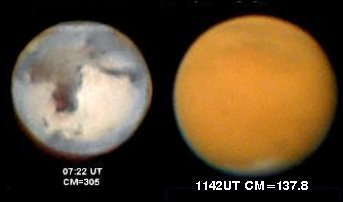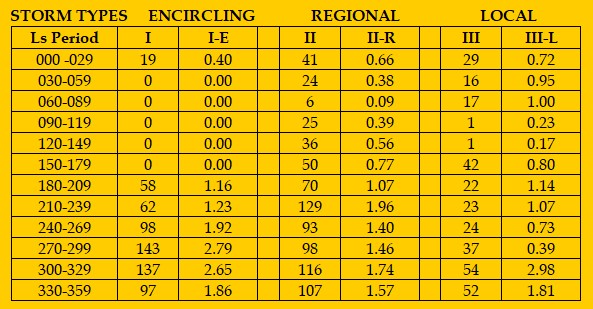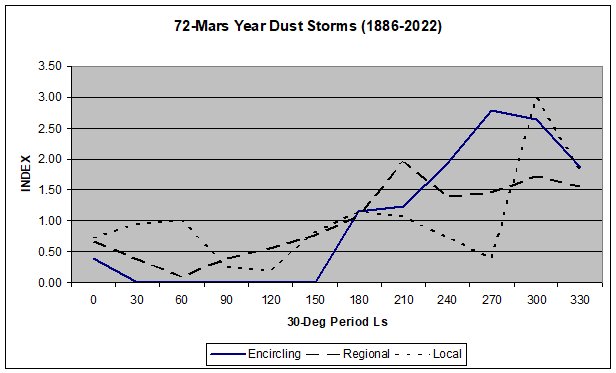
INTRODUCTION
Numerous studies of the meteorology on Mars by the A.L.P.O. Mars Section indicates seasonal periods when we might expect to see a dust storm on Mars [Beish and Parker, 1986], [Beish and Parker, 1987], [Beish and Parker, 1990 and Beish, 1999]. Our hypnosis is confirmed by the results of continued studies throughout the 1980’s and 1990’s and we have found several periods of dust event activity follows very closely to our earlier statistical analysis summarized in "Meteorology of Mars - Part III. As expected, major storms are often observed when Mars is closer to the Sun during Perihelic apparitions.
We now know what the early observers of Mars -- who never had the experience of witnessing a planet-encircling or global storm -- never imagined. Dust appears to be a major player in both short- and long-term climate changes on Mars (for that matter, it is probably more significant than it has hitherto been regarded on Earth; satellite images have recently shown plumes -- virtual rivers -- of dust transported by stratospheric winds from the Gobi desert across the Pacific over a matter of a few days). This was dramatically illustrated during the now-classic Great Dust Storm of 2001 [Schmude, at al, 2004]. As local dust traps sunlight, it heats the atmosphere further. The warmer air flows to cooler regions where it generates local winds and raises more dust. Regional clouds spread continuously. However, a major dust storm often progresses through the quickening of activity at a number of additional cores, as in 2001 and 2018. This appears to represent a classic example of a non-linear response -- true catastrophic phenomena, where only a small change in circumstances, such as an increase in the solar radiation from the Sun, can produce a huge shift [Schmude, at al, 2004].

Figure 1. Two CCD images made during the 2001 apparition of Mars that demonstrates how fast the Red Planet is shrouded in dust when a planet-encircling dust storm occurs. Left image: DC Parker image on 11 June 2001. This shows a fairly clear Mars with a cloud streak or wave in the southwestern Hellas that may have indicated winds in that area. Right image: Kent De Groff on 7 July 2001. Image shows Mars completely enshrouded in dust.
Much has been written about the characteristics of these dust clouds and how to detect them. These dust clouds are very difficult to identify in their beginning stages and, in some cases, go undetected even after they have fully developed. As a general rule, a Martian dust cloud will qualify if they 1) are bright in red light, 2) show movement with obscuration of previously well-defined albedo features, and 3) may cast a shadow. Omitting reported dust clouds and exploring only local, regional and planet-encircling dust storms from 1909, 1924, 1956, 1971, 1973, 1975, 1977, 1982, 2001, 2007 and 2018 we may reveal when these storms may occur. In the past, many of the major dust events occurred during the same seasonal period and led some researchers to refer to these major dust storms as "precursor storms prior to planet-encircling events." When a major dust event does occur during this period then we find that the highest probability of predicting planet-encircling dust storms occurs during mid-southern summer at or near 315° Ls.
The late Leonard J. Martin (Lowell Observatory) classified Martian dust storms in four categories: a local storm is one whose longest dimension does not exceed 2,000 kilometers; a regional storm exceeds 2,000 km in at least one dimension but does not encircle the planet; and an encircling storm spans the circumference of Mars. A global storm covers the entire planet, including the poles [Beish and Parker, 1990] [Martin and Zurek, 1993]. It should be remembered, however, that these global dust storms are quite rare - only eleven have been reported since 1886, and all but two have occurred since 1956. Much more common is the "localized" dust event, often starting in desert regions near Serpentis-Noachis, Solis Lacus, Chryse, or Hellas. During the 1997 apparition, CCD and HST observations revealed localized dust clouds over the north polar cap early in northern spring.
STATISTICAL METHOD
A recent survey by professional researchers shows that dust events can occur during virtually any season [Martin and Zurek, 1993]. Their paper reinforces our study for a main peak period for dust events is 285° Ls (just after southern summer solstice) and a secondary peak has been observed in early northern summer, around 105° Ls. Their paper articulates our hypnosis that dust storms occurring during southern summer are larger and more dramatic. Local dust storms can even grow rapidly to enshroud the whole planet.
An exception to this was the 2001 planet-encircling storm that occurred at around 185 degrees Ls or 65 degrees before perihelion. This was the earliest major storm on record, and it surprised us because is started nearly two Martian "months" before the observed dusty "season" and four "months" before the high probability period of 315° Ls [McKim, 1999 and 2017]. Then the 2018 apparition supplied us with a similar but more extensive spectacle with a global dust storm.
Using a statistical method from a previous study on cloudy period on Mars (Beish, J.D., 2002), I selected methods detailed in a chapter on "Time Series" taken from an old college outline (Longley-Cook, 1970) to show the trends in observed dust cloud activity on Mars during a period from 1886 through 2022, or 72 Mars years recorded as a percentage of each 30-degree Ls period through the Mars year. Our revised analysis indicates that the number of dusty degrees Ls we should expect local storms are more frequent from mid-southern autumn (75° Ls), mid-southern spring (195° Ls) and again in southern summer (315° Ls). Regional dust storms more often occur more frequent between early-southern spring (225° Ls) until the end of southern summer (359 Ls), with two peaks period at 225° Ls and 315° Ls. Planet encircling dust storms are more often observed from early-southern winter (165° Ls) until the late southern summer (359° Ls), with two peak periods at 225° Ls and 315° Ls.
Table 1. A typical set of twelve 30-degree Ls periods of recording the number of Martian dust clouds/storms observed from 1886 through 2022 by various Mars observers and ALPO/IMP and BAA (McKim). The Martian year of four seasonal and 12 sub-seasonal periods start with its vernal equinox at 0° planetocentric longitude (Ls) and moves eastward in its orbit through the seasons or 360 degrees. Column (I, II and III) are the 30 degree period or sub-season total events for each category, Column (I-E, I-R and I-L) is the Seasonal Index for each category.

We can then produce a plot of the times series trend line for discrete clouds observed on Mars during 52 apparitions and forecast an approximate number of dust clouds an observer is likely to see in future apparitions for a particular season. This study has been extended to include the 1909 through 2022 apparitions. Using the first study to test the second time series model it was determined that a very close correlation exists between the two studies (Beish, 1999).

Plot 1. A plot of Martian dust clouds/storms of the average number and trend-adjusted seasonal indices from 1886 through 2022 from Table 1 above. Plot represents the average number of dust clouds/storms observed per degree Ls.
Discussion
Dr. Richard McKim, Director of the Mars Section of the British Astronomical Association (BAA), performed an exhaustive historical study of Martian dust storms and has concluded that there have been only ten planet-encircling events reported since 1909. These took place in 1909, 1924, 1956, 1971, 1973, 1975, 1977 (2 storms), 1982, 2001 and 2007. Of these, only the 1971 and 2001 storms were considered truly "global" [McKim, 1999, 2008, 2017]. Most of the major dust events have occurred during the last three decades and a cursory look at the record reveals that the frequency of massive dust events is on the increase. Then in 2018 Mars experienced the eleventh planet-encircling dust storm and may be classified as a global storm.
While observers were surprised by the planet-encircling storm that occurred the 2001 when global dust storm began in NW Hellas on June 24, 2001 (183.5° Ls) or 66 degrees before perihelion and major dust cloud activity ended on August 02, 2001 (206.4° Ls) while the atmosphere of Mars remained dusty for at least a month thereafter. Then the 2018 apparition surprised us again with a similar but more extensive spectacle with a global dust storm. Discovered on May 31, 2018 (184.9° Ls) a bright dust cloud was seen in Mare Acidarium-Niliacus Lacus that divided and spread southward into eastern Chryse and Xanthe. The storm may have peaked sometime on or about June 22, 2018.
In addition, the great dust storms of 2001 and 2018 were most unusual in that it commenced just after the southern spring equinox. This planet-encircling dust storm occurred during a season when very few dust events of any type had been reported. In view of this increasing frequency and severity of major dust storms, many astronomers predict that there is an excellent chance that Mars will be obscured by dust around opposition time in October 2020. It would seem that a significant shift in the probabilities of a dust storm occurring around the northern autumn/southern spring (180° - 209° Ls) and this should be considered with observers to be aware in those Mars seasonal periods.
Observers should be aware that during the next apparition of Mars in 2020 a major dust storm may occur to block our view of the clouds and surface of the Red Planet (see Figure 1). Massive, planet-encircling storms usually occur in the southern hemisphere summer and usually in sensitive areas for the development of dust storms are in northwest Hellas. While these events are nearly impossible to predict our studies show that the Martian dusty season should begin on or about March 13, 2020 (165° Ls) through the end of the apparition with the highest probability around in mid-June (225° Ls) and again peaking on or about November 15, 2020 (315° Ls).
Do not be surprised if another early dust storm occurs on or about April 17, 2020 (184° Ls). Observers should be alert for dust clouds in the northeast Hellas Basin, the Serpentis-Noachis region, and the Solis Lacus region.
References
Beish, J.D., Parker, D.C., and Capen, C.F. (1986), "Meteorology of Mars - Part I," Journal of the Association of Lunar and Planetary Observers (J.A.L.P.O.), Vol.31, Nos. 11-12, November.
Beish, J.D., Parker, D.C., and Capen, C.F. (1987), "Meteorology of Mars - Part II," Journal of the Association of Lunar and Planetary Observers (J.A.L.P.O.),, Vol.32, Nos. 1-2, March.
Beish, J.D. and Parker, D.C. (1987) , "Meteorology of Mars - Part III," Journal of the Association of Lunar and Planetary Observers (J.A.L.P.O.), Vol 32, Nos. 5-6, October.
Beish, J.D., and D.C. Parker (1990), "Meteorological Survey of Mars, 1968-1985," Journal of Geophysical Research (JGR), Vol. 95, B9, 14657-14675, August 20.
Beish, J.D. (1999), "Meteorological Survey of Mars For Opposition Years 1965 - 1995," The ALPO Computing section Web Page: The Digital Lens, November. http://www.m2c3.com/alpocs/tdl1999/meterological110199/MOM.html
Beish, J.D. (2002), "A Trend Analysis for Predicting Cloudy Periods on Mars," ALPO Internet Web Page: The Mars Section, June 2002. http://groups.yahoo.com/group/Mars-ALPO/files/MetTrend.htm
Martin, L. J. and R. W. Zurek (1993). "An Analysis of the History of Dust Activity on Mars." Journal of Geophysical Research, Vol. 98, no. E2, pp. 3221-3246.
McKim, R. (1999)., "Telescopic Martian Dust Storms: A Narrative and Catalogue," Memoires of the British Astronomical Association, Vol. 44, June 1999.
McKim, R. (2008). " The opposition of Mars, 2001: Part I." Journal of the British Astronomical Association, Vol. 119, no. 3.http://alpo-j.asahikawa-med.ac.jp/kk01/JBAA119123-143McKim.pdf
McKim, R. (2017). "Mars in 2001 - Second interim report" Journal of the British Astronomical Association, Mars in 2001 - https://britastro.org/node/11532
Schmude, Richard, Dan Troiani, Jeff Beish, Deborah Hines, Rich Jakiel, Danial Joyce, Don Parker, Doug West adn Jim Wood, (2004), "ALPO Observations of the 2003 Apparition of Mars," J.A.L.P.O. Vol 46, No. 4, Autumn 2004.